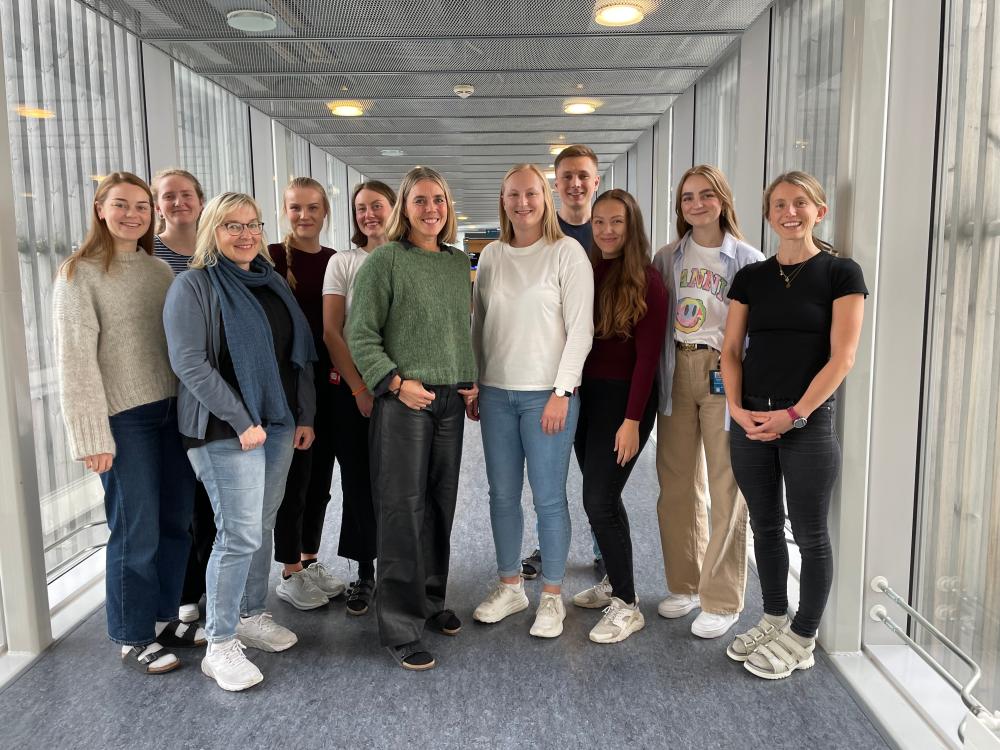Bone microenvironment group at CEMIR - Department of Clinical and Molecular Medicine
Bone Microenvironment Group

Multiple myeloma is a cancer of plasma cells, located within the bone marrow. A hallmark of this cancer is a severe osteolytic bone disease, affecting nearly 80 % of the patients at diagnosis. The bone disease of multiple myeloma is highly aggressive, and is the cause of pain, fractures and reduced quality of life.
We study the bone marrow microenvironment
The cancer cells are dependent on the microenvironment in the bone marrow to survive. Hypoxic and ER stress and a low grade, chronic inflammation characterize the myeloma bone marrow. Our research is centered on identifying infectious and inflammatory factors present in the bone marrow microenvironment that influence plasma cell survival and differentiation and function of bone and immune cells.
Basic and pre-clinical research
We have access to fresh, primary tumor cells from myeloma patients and our in vitro experiments are mainly performed using human primary cells. For in vivo studies we use different models: xenograft models using myeloma cell lines, a syngeneic mouse model established in the Chesi/Bergsagel lab at the Mayo Clinic in Arizona, US, or a human-mouse scaffold model developed in the laboratory of Anton Martens, the Netherlands. The close collaboration with the Department of Hematology at St. Olavs combined with the relevant pre-clinical models is key in our search for new treatment targets. From March 2021 we are part of the newly established clinical academic group (CAG) for multiple myeloma research in Central Norway and we also collaborate closely with the Nordic Myeloma Study Group.
Research documentation
10 selected publications
10 selected publications
- Aass KR, Mjelle R, Kastnes MH, Tryggestad SS, van den Brink LM, Roseth IA, Westhrin M, Zahoor M, Moen SH, Nedal TMV, Buene G, Misund K, Sponaas AM, Ma Q, Sundan A, Groen RW, Slørdahl T, Waage A, Standal T. Intracellular IL-32 regulates mitochondrial metabolism, proliferation, and differentiation of malignant plasma cells. iScience. 2021 Dec 13;25(1):103605. doi: 10.1016/j.isci.2021.103605.
- Westhrin M, Kovcic V, Zhang Z, Moen SH, Nedal TMV, Bondt A, Holst S, Misund K, Buene G, Sundan A, Waage A, Slørdahl TS, Wuhrer M, Standal T. Monoclonal immunoglobulins promote bone loss in multiple myeloma.Blood. 2020 Dec 3;136(23):2656-2666. doi: 10.1182/blood.2020006045.
- Zahoor M, Westhrin M, Moen SH, Aass KR, MisundK, Psonka-Antonczyk KM, Giliberto M, Buene G, Sundan A, Waage A, Sponaas AM and Standal T. Hypoxia promotes IL-32 expression in myeloma cells, and high expression is associated with poor survival and bone loss. Blood Adv. 2017 Dec 13;1(27):2656-2666. doi: 10.1182/bloodadvances.2017010801.
- Westhrin M, Moen SH, Holien H, Mylin AK, Heickendorff L, Olsen OE, Sundan A, Turesson I, Gimsing P, Waage A, Standal T. GDF15 promotes osteoclast differentiation, inhibits osteoblast differentiation and high serum GDF15 levels are associated with multiple myeloma bone disease. Haematologica. 2015 Dec;100(12):e511-4. doi: 0.3324/haematol.2015.
- Standal T, Johnson RW, McGregor NE, Poulton IJ, Ho PW, Martin TJ, Sims NA. gp130 in late osteoblasts and osteocytes is required for PTH-induced osteoblast differentiation. J Endocrinol. 2014 Nov;223(2):181-90
- Grandaunet B, Syversen S, Hoff M, Haugeberg G, Sundan A, van der Heijde D, Kvien T and Standal T. Association between high plasma levels of hepatocyte growth factor and progression of radiographic damage in the joints of patients with rheumatoid arthritis. Arthritis Rheum. 2011;63:662-669
- Nørgaard N, Holien T, Jönsson S, Hella H, Espevik T, Sundan A and Standal T. CpG-oligodeoxynucleotide inhibits Smad-dependent bone morphogenetic protein signaling: effects on myeloma cell apoptosis and in vitro osteoblastogenesis. J Immunol. 2010 ;185:3131-3139.
- Jönsson S, Hjorth-Hansen H, Olsson B, Wadenvik H, Sundan A and Standal T. Second-generation TKI dasatinib inhibits proliferation of mesenchymal stem cells and osteoblast differentiation in vitro. Leukemia 2010;24:1357-1359
- Standal T, Abildgaard N, Fagerli UM, Stordal B, Hjertner O, Borset M and Sundan A. HGF inhibits BMP-induced osteoblastogenesis: possible implications for the bone disease of multiple myeloma. Blood. 2007; 109:3024-3030
- Standal T, Seidel C, Hjertner Ø, Plesner T, Sanderson R, Waage A, Borset B and Sundan A. Osteoprotegerin is bound, internalized, and degraded by multiple myeloma cells. Blood. 2002;100:3002-3007
PubMed
PubMed
Publications by Therese Standal - PubMed
"Standal T OR NJ t"
NTNU Open
Collaboration
- Toma Tebaldi, Department of Cellular, Computational and Integrative Biology (CIBIO), University of Trento, Italy.
- Manfred Wuhrer, Leiden University Medical Center (LUMC), The Netherlands
- Niels Abildgaard, University of Southern Denmark (SDU), Denmark
- Unni Syversen, Norwegian University of Science and Technology (NTNU)
- Berit Strand, Norwegian University of Science and Technology (NTNU)
